Table of Contents
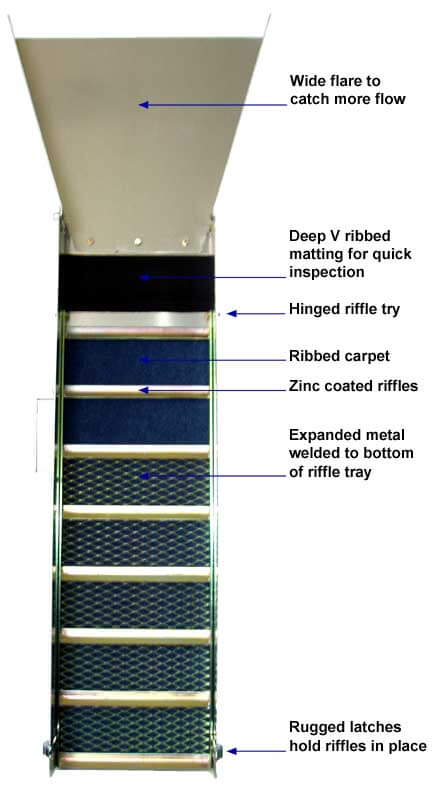
This week I went and asked “how to SIZE a sluice box” to the crew on a large gold prospector forum and other sluice or gravity gold recovery ‘experts’ and gathered the list of emails and forum posts here below. As you will see, in summary, most can optimize or troubleshoot a sluice box but few or none can size a gold sluice box.
_______
I want to process 1 TPH (60 liters/min) of solids, what size a sluice box set-up do I need? How much sluicing area? How wide, how long should the sluice be?
_______
Following values are recommended in Poling’s (1989) and Clarkson’s (1990) scientific sluice box studies:
– heavy (6mm thick) non-flattened expanded metal riffles need 2400 ls/min of water per width meter of sluice for to work properly
– one inch high angle iron riffles need double quantity i.e. 4800 ls/min of water per width meter of sluice
– the slurry flowing in the box should contain <12% of solids by volume (how much water does a gold sluice need).
Given water volumes are absolute minimum volumes, any less will cause gold losses. Exceeding them up to 50% is not serious.
So, for 60 ls of solids per minute you would need (about) 600 ls/min of water in your expanded metal rifle section which would then be 25 cm wide. Angle iron section should off course be just half of that width for proper water flow.
Slurry velocity in sluice should be 1,5 – 1,8 m/s for expanded section and 1,8 – 2,2 m/s for angle iron.
How long? Well, in these studies they used about 2,5 m long riffle sections with 2 m long slick plates before each section for to give time to heavies to drop to the bottom of the box before they hit riffles.
The studies were made for commercial scale operations. I would recommend that you read them by yourself and make your conclusions. Anyway these are only scientific studies made about the subject this far. All the rest is just commercials and opinions.
What Angle Should a Gold Sluice Be Operated At
______
It’s 1 TPH of solids at SG 2.8 –> 1000 kg/hr at 12% Solids = 1000/.12 – 1000 + 1000/2.8 = 7700 l/hr = 128 l/min is my diluted flow feeding the sluice.
From there, 128/2400 x 100 = 5-6 cm wide
Where am I going wrong? How to SIZE a sluice?
_______
First consideration is, what is the character of the material you will be putting through your sluice?
Poling and Hamilton’s work is for machine fed operations.
Your desire for 1 TPH is roughly 2/3rds cubic yards an hour.
Placer is usually figured by cubic yards or meters. Hard-rock is in tons/tonnes.
That being said, 2/3CY is right at the limit for hand-fed operations.
This equates to roughly 5-6CY/long day.
Now the bigger question is, “Can this be done every day?”
Only if the person is young, in excellent shape and the material is small enough to fit on a shovel.
Large cobbles and boulders (>12-15cm) will slow your feed rate considerably.
Now we have to know the probable size range of the gold in your deposit.
The reason behind this is why run grossly over-size not-gold through the sluice?
Grossly over-size requires more water at a higher velocity to clear it from the sluice.
This makes recovery of small gold drop substantially due to uncontrolled turbulence caused by over-size material.
You might also be interested to know we have recently performed a review of the very best sluice box as of 2021 and beyond.

So knowing the character of the material and the required maximum feed classification will give you the actual feed in cubic.
There is every probability that unless you are feeding straight sand off a beach, your actual feed for 2/3 CY per hour (18 cubic feet) bank-run might be as low as 2-3 cubic feet per hour. How do I know this? I actually have hand classified material (-4 mesh) in my area and measured it by weight. ~10 lbs per #2 shovel load with 3300 lbs per cubic yard.
Now as you haven’t mentioned anything other than sluice, the question then becomes one of, “What are you going to use for washing the material?”
Straight bank run will require a substantially longer sluice than well washed material.
Clay seems to have an affinity for small gold. It glomps on and doesn’t want to let loose. The clay also sticks to the rocks, so you have rocks coated with clay and a few sprinkles of gold as well. Why feed gold into a sluice only to loose it off the end.
All this being said, the typical size for a hand-fed sluice and high-banker is 10″ wide. Classifying smaller than 1/4″ slows the operation down substantially (yes, there are a few work-around). Very few folks can effectively use sluices larger than 12″ in hand fed operations. Water requirements are about 28-30 gpm with more being better. You can always cut back on the pump’s throttle.
If you are classifying down to 1/4″, water requirements can be lower but pressure must go higher to effectively wash the feed.
As an example, I classify to 1/4″, my pump’s maximum output is 28-30gpm, but at the pressure required for effective washing reduces the volume to 15-20gpm. Better quality pumps should show a pump curve in the manual. Most of my sluices are 10″ wide and few are longer than 3 feet.
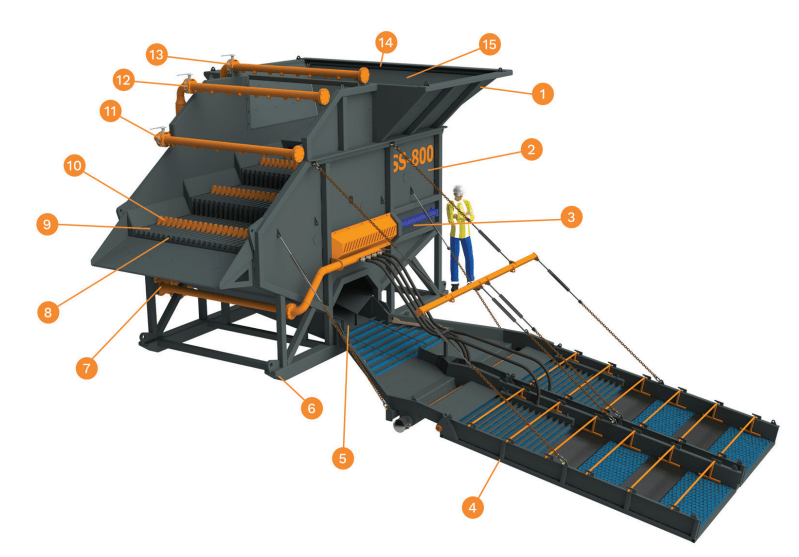
Be sure to check the regulations in your state or province for what is or is not legal.
I gave all this due to your asking the most basic question making me think you are relatively new to the business/hobby.
That being said, learn to effectively use a gold pan first. The pan is the most effective recovery device made and is an integral tool for sampling a deposit for economics. If you have a significant other, spending money on tools that won’t pay their way is a quick way to find interpersonal conflict. Sampling will reduce the probability of said conflict. If you can’t get at least 5-10 grains a day with a pan, walk away from the deposit. At today’s spot price (~$1090 USD), 5 grains is about $7USD. Using a high-banker might raise your daily gross to $50-70 for the same deposit. I want to emphasize that that is GROSS not net. You have to strip out all the expenses, gas for the pump, amortization of the equipment, transportation costs, food and drink that you bought for the trip, etc.
Hope and dreams are not an effective strategy to avoid interpersonal conflict at home.
Sample with a pan. Sample with a pan over and over again. There are many folks that can consistently make beans with a pan. A few can process well over a cubic yard of bank-run a day. $10-$12 for the pan versus $600-$1000 for a high-banker and pump. Think about it, for someone experienced $10 for 1CY/day versus $600 for 5CY/day.
Also by using a pan for sampling, it is easy to combine that with a bit of fishing as well. Bringing home a stringer of fish is a lot better for a relationship than stating, “There, right there, see those 6 flakes”, when all you significant other sees is a depleting bank account.
_______
I read from your post that you would feed 60 liters per minute. Now i understand that your feed rate is not 60 but 6 litres per minute. Sorry for my mistake.
Use of the values mentioned in those studies would be in-practical in your case i suppose.
I have 15 cm wide angle iron riffle sluice-box followed by 30 cm wide expanded metal sluice box, 1000 l/min water pump and six men shovelling dirt into flume. My practical feed rate is about 60 litres per minute. It works well.
_______
By my opinion, this would require a table of some kind rather than a sluice box, a Miller, shaker or wave table. At least i know that Miller tables are good in catching flaky gold and particles coming out of ball mill will be flaky. Miller table is cheap and easy to make DIY but requires a person all the time. For 6 litre per minute feed the table should be two meters wide at least and that would be difficult to handle for one person.
——————
It is not 6 l/m it is 128 l/m
Tables has slimes and fines.
So, a 6″ sluice x 10′ long? How did I SIZE this sluice?
_______
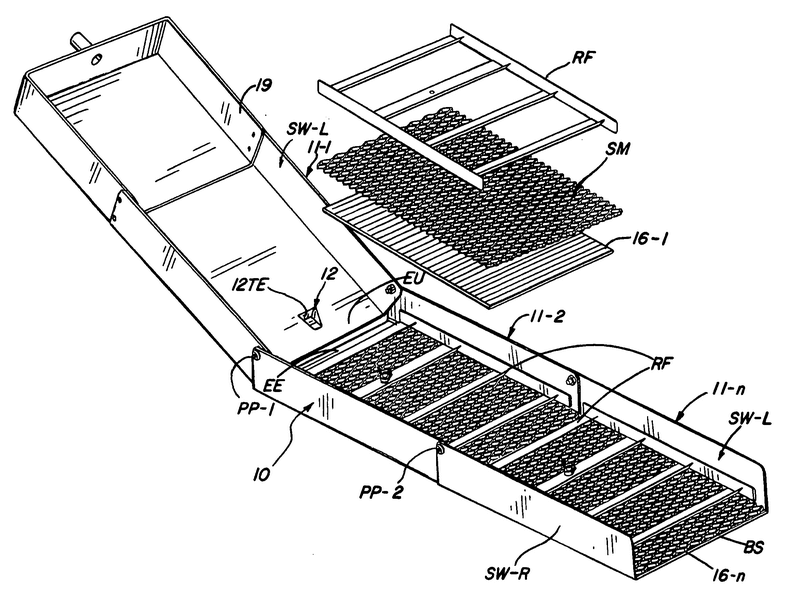 My suggestion is to give Doc at GoldHog in the US a call – explain what you are doing and pick his brain. I have not talked to him directly, but heard him on a radio show and have watched all his videos with interest. He knows what he is talking about. He constantly tests and develops placer equipment. On the radio show, he told people to talk to him directly with their circumstances and he would provide his input. There are many factors to consider, not just sluice size – changing up one thing will impact other things.
My suggestion is to give Doc at GoldHog in the US a call – explain what you are doing and pick his brain. I have not talked to him directly, but heard him on a radio show and have watched all his videos with interest. He knows what he is talking about. He constantly tests and develops placer equipment. On the radio show, he told people to talk to him directly with their circumstances and he would provide his input. There are many factors to consider, not just sluice size – changing up one thing will impact other things.
At the end of the day, test your tailings to see what is being lost and make the necessary adjustments. If you are building something from scratch, then a general rule is longer is better if you have the water volume to run it.
_______
I see I assumed this was placer.
As the subject has now moved outside my area of expertise, all I can offer is an opinion based upon my limited understanding.
With the grind to 200 mesh @ 1tph, I don’t think a sluice is the best recovery device.
The reasons are:
200 mesh is 75 microns. At that size, almost any turbulence in the water will keep the gold in suspension.
Now granted, 200 mesh is the screen size and there is always some over-grind. So anything larger than 200 mesh is sent back around while the -200 is passed.
200 mesh makes a serious slurry and if there is much feldspar in the grind, you are gonna get clay. Clay and sluice boxes don’t get along well when the feed is a thick slurry.
Lengthening the box brings in a periodic transverse current that reintroduces turbulence in the flow. The general flow in a sluice should be as laminar as possible to permit gravity to be the major influence in material transport. You want controlled turbulence at the bed. This turbulence, like any other, reduces the velocity of the water right up against it. So the problem is you have a real small particle of gold that falls relatively slow through a stable water, now being in a flowing water column. Because of its size and weight, ant turbulence keep the particle either in suspension or in long skips. This argues for a longer sluice to catch the skippers. But there is that periodic turbulence reintroducing more turbulence. It is a catch-22. Longer to catch, but reintroduce turbulence which requires longer.
So not just a sluice, I don’t think any of the standard gravity devices is a good idea.
Now if you consider enhanced gravity devices, I think you could achieve high recoveries and a reasonable throughput.
Bowls come to mind.
Introducing higher gravity permits lots more turbulence and creates a far higher difference in effective specific gravity.
Think about it for a moment. Keeping this simple by analogy, at 1 gravity, a 5kg box is 4kg heavier than a 1kg box.
At 10 gravities, the 5kg box now weighs 50kg and the 1kg box is 10kg with a 40kg difference. Higher gravity makes even slight differences in S.G. become substantial differences in effective S.G.
There is also the elutriation tank. Supposedly quite effective as long as the material is small and the classification range is somewhat narrow. From my understanding, these are relatively easy to tune for maximum recovery.
Then there is the hydrocyclone. I have a couple, three reports on their use published by the MIRL University of Alaska Fairbanks. They are also available on the web. Looks to be real effective with a fairly high purchase price. Tuning appears to be balancing act and the feed requirements fairly narrow.
Please understand one more time, my areas of expertise are panning and hand-fed sluices predominantly in the form of high-bankers. Everything else is purely opinion with only some to no practical experience.
_______
Thanks,
it bring me back to the original question which I will reformulate:
What size of sluice is needed to to process 1 TPH of solids at SG 2.8 produced from hard-rock mining. Let’s grind it to P80 = 150 mesh
–> 1000 kg/hr at 12% Solids = 1000/.12 – 1000 + 1000/2.8 = 7700 l/hr = 128 l/min (18 gpm) is my diluted flow feeding the sluice.
_______
THE (repeat THE) best info for your specific question is that put up by Sunshine — call (or email) to discuss your specific situation with “Doc” at Gold Hog. Their matting is able to capture the very small sizes of Gold (I have personally seen -100 easily captured) —– however —– there are other considerations like specific flow rates of water and processing a specific type material (all small particle slurry) that are unique to you.
We who dwell here, and as it is in almost all other forums, are not really familiar with hard rock recovery techniques. Recovery of small Gold sizes, yes, but not 128 L/minute of very fine slurry (or was that just the solids?) of the type composition you mention.
_______
128 l/min is slurry.
_______
So you have 128 L/Min, which is 7,680 L/Hr, which is 2030 Gal/Hr.
Gold Hog mats use ~ 100+- Gal/Hr per inch of sluice width for roughly classified bank run material. Because you are using a highly classified particle size the “usual” numbers probably do not hold up — however — IF they did, then:
The magic number sized width of sluice (using Gold Hog Mats) would be ~ 20″ wide. Realizing that the Hog Mats come in 36″ widths and it is recommended for commercial operations to go to 18″ for ease of handling I would say go with 18″ width and back off a little on the input material into the slurry. Which of the half dozen mats to use? Go to the source – Doc.
Now, other systems of recovery (Carpets, Moss, Drops, Hungarian Riffles, Expanded Metal, Lath etc) it’s any body’s guess.
Now as to length of the sluice box – I would guess about 8 feet long. Why? Offsetting factors – tightly classified slurry and small Gold. Now I have to guess here, whereas others who work with this ‘stuff’ every day can give a stronger answer. Again, go to Doc to ask this type of specific question. A proper answer needs specific experience. You’re not committing yourself to buying in on his system — you’re just learning from him.
One other thing — this entire string is revolving around numbers. Mining is taught in schools in the only way they can – “hard” numbers and formulae. Those who mine take the things they did learn in schools and use that base to get actual hands-on knowledge and then, as experience evolves, successful production. There are an infinite number of variables in play while mining — sometimes you just have to “feel the force” in the Yoda _______
OK now,
I really shouldn’t be getting into this, but some fundamental things need to be highlighted here.
You want to process 2,000 pounds of -150 rock per hour with 240 US gallons of water – How many gallons in 1 ton of water . TO ME, that would need at least a lot more volume of water to process that slurry. A Ton to Ton ratio of solids to water is like trying to process fairly thin tooth paste!
What are you using now? Width of your sluice, water flow and feed rate, drop of the sluice and recovery medium.With ground up rock of this small diameter you should not be worried with having to classify your input material! Yahoo!! Here is an idea of the various “stock” highbankers and their feed rates (bank run material), https://www.flipsnack.com/goldhog/gold-hog-sluice-matting-product-catalog.html
Capture the tailings and test for losses. No losses, increase feed rate and pitch of the sluice until you get losses (and then back off a little).
A possibly way to look at this is to pump into a test sluice of, oh jeez, say 18 inches wide. 8 feet long and at about 11 – 13 degrees of pitch. At 1,800 gallons of water per hour (watch the Gold Hog videos to see what ‘things’ should look like) it won’t have long to figure things out.
https://www.youtube.com/user/georgiagoldguy/videos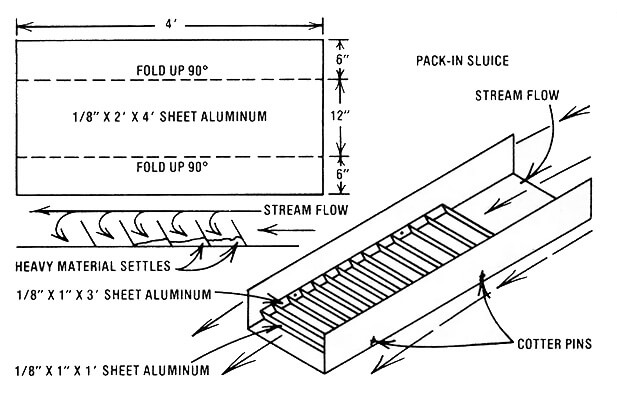
Met, you have to design your system to provide either basic material feed rate or water volume as a start to the recovery system. If 1 TPH is your actual starting criteria then make everything else match that starting point. If you have to increase the water (60% solids is VERY high as I see it) then do it.
_______
Mike (from Gold-Hog) was answering his questions from his inquires at our website.
I check every reply that goes through the system and sort of felt the same as he did.
There was no real “starting point” for the system and we really don’t spec out entire recovery systems.
We base a matting configs on known values mainly looking at material run, water volume, sluice width, length, delivery method into the sluice, etc.
Hence the need for NINE mats………..
Crushing / hard-rock / milling ops have different needs than placer ops.
Many larger ops also treat their ore in several stages. Med crush, fine crush, and super fine, etc.
In the final stages, the water needs to very soft, shallow, and very limited turbulence.
I would say 100 – 200 gallons per inch and then adjust the pitch until fine tuned.
However, as pointed out earlier, 150 – 300 mesh gold can remain suspended if not tuned properly.
When you go really fine…….. a different process is used.
That being said………
At the 100 – 150 mesh range……….
100 – 150 gallons per inch width running alternating Razorback and Down Draft would do a good job.
I might even start the system with moss and 1/2″ expanded for a few feet, then switch over to mats.
It’s always good to offer gold LOTS of choices where it can hide.
_______
1000 gpm for a unit that’s only processing a ton per hour of very fine sand and/or grindings seems unnecessary and imbalanced. We easily process several yards of gravel per hour with a 12” wide sluice box on 120 to 150 gpm.
If you can’t reduce water flow, I’d recommend a box in the 26” width for very fine material. Maybe one of our 8” Dredge sluice boxes, with a slightly different riffle profile and two dampers to help break surface tension for ultra fine material.
To run fines on as little as 18 gpm, you should start off with a sluice box no narrower than 8” and no wider than 10”. As for length, maybe something in the 6′ to 8′ range. However, you won’t be able to effectively process a ton per hour of 150 mesh material and maintain a high rate of recovery.
With such a limited water flow rate, you’ll use a relatively narrow sluice box in order to have acceptable water speed and depth over the riffle set.
With material this fine, you’ll need to feed it at a slow, steady pace (due to the lack of water flow) in order to prevent the riffles from becoming overwhelmed at times from an inconsistent feed and/or overfeeding.
_______
THE END OF How to SIZE a Sluice Box
You might learn more at https://www.instructables.com/id/A-recirculating-sluice-box-for-gold-prospecting/ and https://www.google.com/patents/US20120000834
Optimum Slope of a sluice
Slope of a sluice is generally in the range of 1.3 cm (1/2 in.) to 3.8 cm (1-1/2 in.) per 30.5 cm (1 ft), depending on the size rock in the feed. To move the larger rocks down the sluice requires a steeper slope or more water, both of which cause greater gold losses. Any number of types of collectors can
be used in a sluice. Most common is the use of astroturf or indoor-outdoor carpeting under expanded metal. These are plastic products which are used in place of the traditional wool carpets, gunny sacks or cocoa matting.
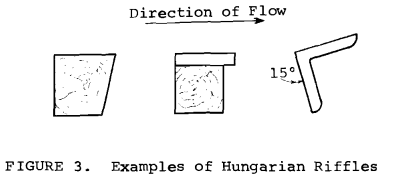
The plastic carpets are much easier to clean and if washed thoroughly, have no chance of carry-over from one sample to the next. These are lightweight and dry quickly.
Riffles can be of cross slats of wood or metal, either square wood or metal bars. An improvement on a common riffle is the Hungarian Riffle, which is one with an overhang, as shown in Figure 3. This over hang gives an eddy in the flow of pulp, thereby allowing the small gold particles a chance to settle. Other riffles can be of blocks of wood, round tree branches or rocks. I have seen the floor of a sluice with shallow, staggered 5 cm (2 in.) diameter holes and a little mercury in each. This method is particularly good for fine muck containing fine gold. In sum, types of riffles used are a matter of personal preference, or at times, limited by the materials at hand.

Long Tom
A Long Tom is actually a variety of a sluice. It differs in that it has a means of screening out gravel and cobble, thereby allowing less water and a flatter slope. Long Toms are of a wide, short configuration, and are normally a production machine fed by shovel or wheelbarrow.
However, they can be any size, depending on the samples treated. (SeeFigure 4)
Motorised Sluices
There are any number of machines on the market with spray-bars over a vibrating screen. The screen, usually 6.4 mm (1/4 in.) or 9.5 mm (3/8 in.) mesh, feeds to a sluice, usually of carpeting and expanded metal. These machines reduce the work load and are faster than a common sluice, but still risk the loss of fine gold.
